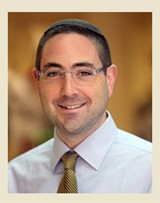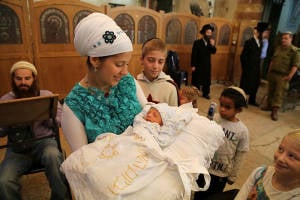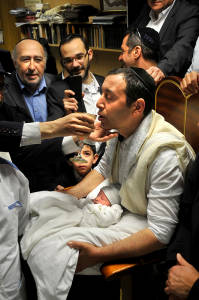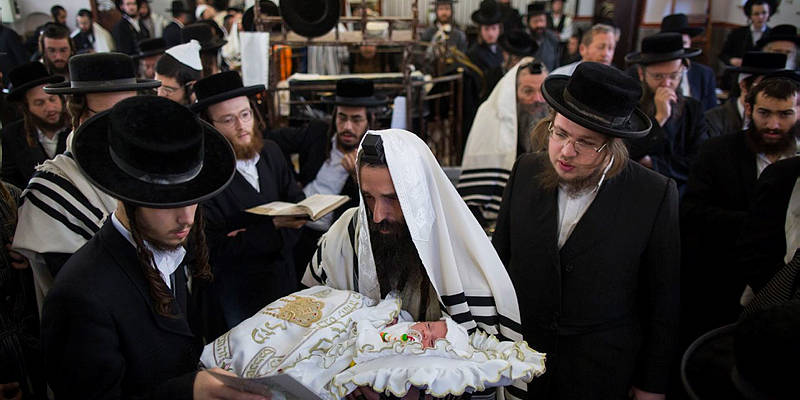
By Rabbi Ari Enkin, rabbinic director, United with Israel
In a previous article on Brit Milah, we looked at the primary components of the circumcision ceremony. In this installment, we’ll look at the honorary roles and rituals, along with some interpretations on the meaning and symbolism.
The ‘Kvatter’ Team
The kvatter (male honoree) and kvatterin (female honoree) are those who essentially begin the Brit Milah ceremony, at least according to Ashkenazi custom. The kvatter and kvatterin carry the baby from his mother to his father. The father, now in possession of his son, delivers the son to the mohel and appoints him as his emissary to perform the circumcision. (See first installment on Brit Milah for more on this). Once the kvatters begin performing their role, everyone present should stand and remain so until the end of the ceremony.
This honor is usually given to a childless couple. This is because it is taught that serving as kvatter/kvatterin is considered to be an “omen” for having children. Although the kvatters are usually a husband-and-wife team, it could also be a daughter and father, a mother and son or a sister and brother. The kvatters should be dressed in their finest clothing in order to reflect the sanctity of the event and the important role bestowed upon them. The kvatter usually wears his tallit (prayer shawl). There is also a widespread custom to appoint a number of kvatter teams in order to allow as many people as possible the opportunity of participating in the ceremony. In such a situation, the kvatter teams passes the baby to one another until the last one hands the baby to the father.

A Brit Mila ceremony at the Cave of the Patriarchs synagogue in Hebron, December 2014. (Gershon Elinson/Flash90)
Chair of Elijah
Every Brit Milah includes a chair for Elijah the Prophet, who is said to be present at each one (as well as at every Passover seder). Elijah is called the “Angel of the Covenant.” Most synagogues have a designated, elaborate, and ornamental chair for this purpose. At the brit, one of the attendees is given the honor of placing the baby on the chair of Elijah. A number of verses and readings related to Elijah are then recited. We are taught that in Elijah’s honor, the sins of all those present are forgiven. That means that attending a brit is like having a mini Yom Kippur!
The Sandek
One of the participants at the brit is honored with lifting the infant from the chair of Elijah and handing him to the father. The father, in turn, places the baby on the lap of the sandek, his representative, who holds the baby during the circumcision. After the sandek sits down, his hands are sanitized with alcohol. He is shown by the mohel, ritual circumciser, how to sit and properly hold the baby during the brit so that he does not move. The sandek should be a pious person. Our sages teach that the qualities possessed by the sandek are passed on to the baby. Many families have the custom to honor the two grandfathers as the sandek for the first two children, respectively.

The ‘sandek’ holds the baby at a circumcision ceremony in Paris, April 2014. (Serge Attal/Flash90)
It is taught that the sandek’s lap is compared to the altar of the Holy Temple in Jerusalem. So, too, the circumcision ceremony itself is compared to the incense ceremony that was offered daily in the Temple. It is taught that serving as a sandek is an omen for becoming wealthy and living a long life! For these reasons and more, some have the custom of purchasing the honor!
The Brit: Reasons and Interpretations
Hellenistic Jewish philosopher Philo (25 BCE-50 CE) gave six interpretations regarding the practice of circumcision. They are certainly interesting, although I am unsure as to whether the medical and scientific communities would agree with them:
1. Circumcision protects against disease.
2. Circumcision improves cleanliness.
3. The circumcised portion of the male organ resembles a heart.
4. Circumcision helps the flow of semen and, by extension, reproduction.
5. Circumcision signifies the excision of all superfluous and excessive pleasure.
6. Circumcision is a symbol of a man’s self-knowledge.
Rabbi Saadia Gaon (882-942 CE) considers something to be “complete” if it neither lacks anything nor has something that is unneeded. Since the foreskin is an unnecessary part of the body, by removing it we become partners with God in the completion of man.
The Rambam, or Maimondes (1135-1204), who apart from being a great Torah scholar was also a physician and philosopher, writes that the main intention in circumcision is to curb a man’s sexual desire.
Do You Love Israel? Make a Donation - Show Your Support!
Donate to vital charities that help protect Israeli citizens and inspire millions around the world to support Israel too!
Now more than ever, Israel needs your help to fight and win the war -- including on the battlefield of public opinion.
Antisemitism, anti-Israel bias and boycotts are out of control. Israel's enemies are inciting terror and violence against innocent Israelis and Jews around the world. Help us fight back!



